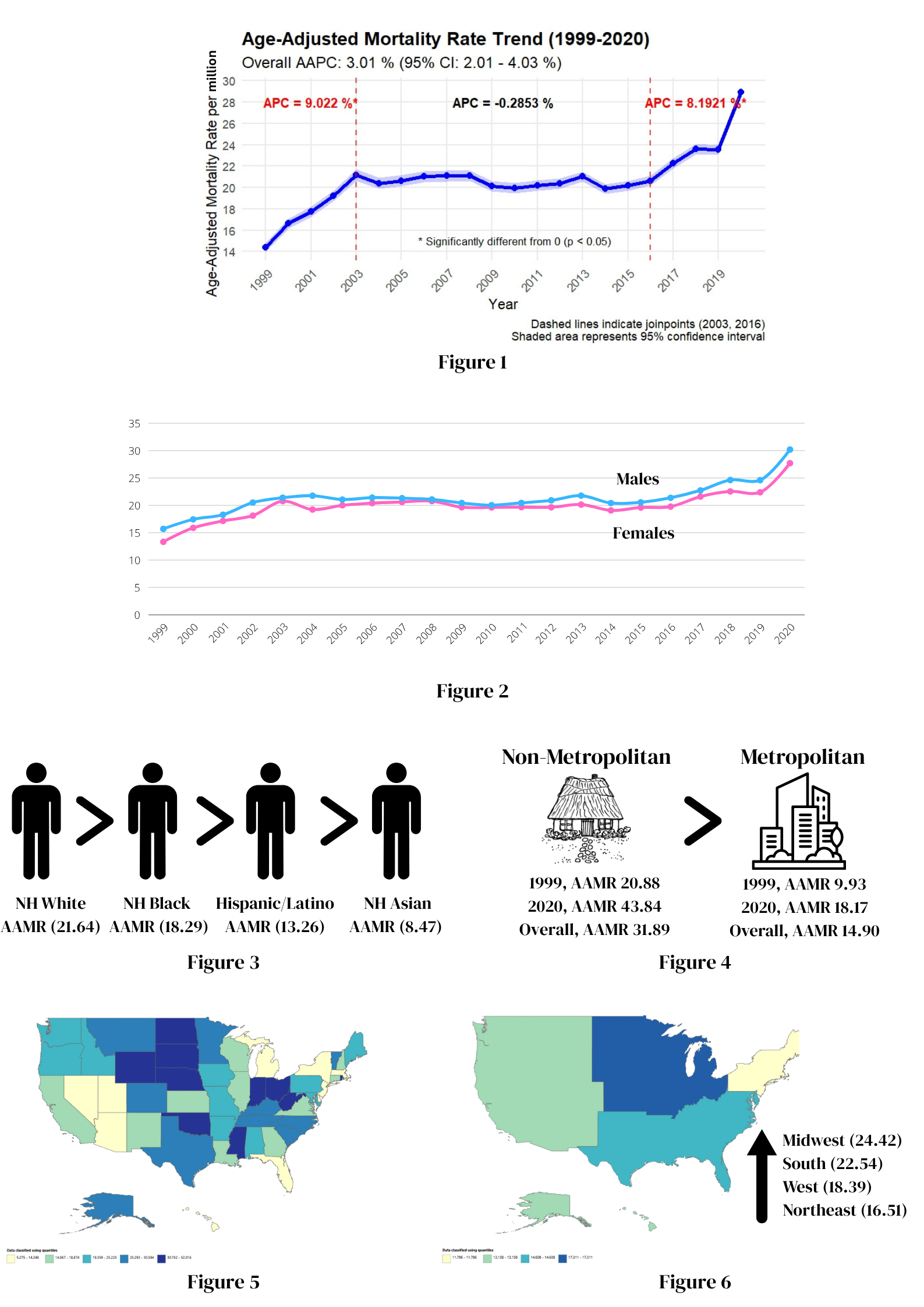Sunday Poster Session
Category: Esophagus
P0678 - Gastroesophageal Reflux Disease-Related Mortality Trends in the United States 1999-2020: An Analysis of the CDC WONDER Database
Sunday, October 26, 2025
3:30 PM - 7:00 PM PDT
Location: Exhibit Hall

Sana Altaf, MBBS (she/her/hers)
Deccan College of Medical Sciences
Irving, TX
Presenting Author(s)
Maha Sajjad, MBBS1, Sana Altaf, MBBS2, Sajjad U.. Hasan, MBBS, MPH3, Muhammad Imaz Bhatti, MBBS1, Ayema Sajjad, 4, Zahin Shahriar, MBBS5, Haram Aftab, MBBS6
1King Edward Medical University, Lahore, Lahore, Punjab, Pakistan; 2Deccan College of Medical Sciences, Irving, TX; 3Amna Inayat Medical College, Sheikhupura, Pakistan, Lahore, Punjab, Pakistan; 4Fatima Memorial Hospital, Lahore, Punjab, Pakistan; 5Dhaka Medical College and Hospital, Dhaka, Dhaka, Bangladesh; 6King Edward Medical University, Lahore, Punjab, Pakistan
Introduction: Gastroesophageal reflux disease (GERD) affects approximately 20% of adults in the United States and is one of the most common gastrointestinal disorders globally. It is associated with complications such as esophagitis, Barrett’s esophagus, and esophageal adenocarcinoma, posing significant health risks. Despite its significant burden, national mortality trends and demographic disparities remain poorly characterized. This study aims to analyze temporal patterns and regional differences in GERD-related mortality in the U.S. from 1999 to 2020.
Methods: GERD-related mortality data were extracted from the CDC WONDER Multiple Cause of Death database using ICD-10 code K21. Crude mortality rates (CMRs) and age-adjusted mortality rates (AAMRs) were calculated per million people. Temporal trends were assessed using annual percent change (APC) and average annual percent change (AAPC) via the Joinpoint regression analysis.
Results: Between 1999 and 2020, 154,548 GERD-related deaths were recorded in the U.S. The AAMR demonstrated an overall increasing trend with an AAPC of 3.01% (95% CI: 2.01 to 4.03). Mortality rates exhibited three distinct phases: a significant rise from 1999 to 2003 (APC = 9.02%), relative stability from 2003 to 2016 (APC = -0.28%), and a resurgence from 2016 to 2020 (APC = 8.19%). Mortality rates were higher in males (AAMR: 21.63) than in females (20.11) and were more pronounced in Whites (21.64) compared to Blacks or African Americans (18.29). Non-Hispanics had a higher mortality rate than Hispanics or Latinos (AAMR: 21.46 vs. 13.36). Regional differences were notable, with the Midwest reporting the highest AAMR (24.42), followed by the South (22.54), West (18.39), and Northeast (16.51). States with the highest mortality included Mississippi, West Virginia, Ohio, Wyoming, and Oklahoma. Micropolitan areas exhibited substantially elevated mortality (AAMR: 31.89) compared to metropolitan areas (14.90). Adults aged ≥85 years showed the highest CMR (527.07).
Discussion: GERD-related mortality in the U.S. has risen significantly from 1999 to 2020, with an alarming acceleration in recent years. Higher rates were observed among males, Whites, non-Hispanics, older adults, and residents of the Midwestern region. These trends highlight the urgent need for targeted public health strategies to address high-risk populations and optimize disease management pathways.

Figure: Figure 1: Overall age-adjusted mortality rates per million
Figure 2: Sex-stratified trends (age-adjusted mortality rates per million)
Figure 3: Racial disparities (age-adjusted mortality rates per million)
Figure 4: Urbanization trends (age-adjusted mortality rates per million)
Figure 5: State-stratified trends (age-adjusted mortality rates per million)
Figure 6: Census region-stratified trends (age-adjusted mortality rates per million)
Disclosures:
Maha Sajjad indicated no relevant financial relationships.
Sana Altaf indicated no relevant financial relationships.
Sajjad Hasan indicated no relevant financial relationships.
Muhammad Imaz Bhatti indicated no relevant financial relationships.
Ayema Sajjad indicated no relevant financial relationships.
Zahin Shahriar indicated no relevant financial relationships.
Haram Aftab indicated no relevant financial relationships.
Maha Sajjad, MBBS1, Sana Altaf, MBBS2, Sajjad U.. Hasan, MBBS, MPH3, Muhammad Imaz Bhatti, MBBS1, Ayema Sajjad, 4, Zahin Shahriar, MBBS5, Haram Aftab, MBBS6. P0678 - Gastroesophageal Reflux Disease-Related Mortality Trends in the United States 1999-2020: An Analysis of the CDC WONDER Database, ACG 2025 Annual Scientific Meeting Abstracts. Phoenix, AZ: American College of Gastroenterology.
1King Edward Medical University, Lahore, Lahore, Punjab, Pakistan; 2Deccan College of Medical Sciences, Irving, TX; 3Amna Inayat Medical College, Sheikhupura, Pakistan, Lahore, Punjab, Pakistan; 4Fatima Memorial Hospital, Lahore, Punjab, Pakistan; 5Dhaka Medical College and Hospital, Dhaka, Dhaka, Bangladesh; 6King Edward Medical University, Lahore, Punjab, Pakistan
Introduction: Gastroesophageal reflux disease (GERD) affects approximately 20% of adults in the United States and is one of the most common gastrointestinal disorders globally. It is associated with complications such as esophagitis, Barrett’s esophagus, and esophageal adenocarcinoma, posing significant health risks. Despite its significant burden, national mortality trends and demographic disparities remain poorly characterized. This study aims to analyze temporal patterns and regional differences in GERD-related mortality in the U.S. from 1999 to 2020.
Methods: GERD-related mortality data were extracted from the CDC WONDER Multiple Cause of Death database using ICD-10 code K21. Crude mortality rates (CMRs) and age-adjusted mortality rates (AAMRs) were calculated per million people. Temporal trends were assessed using annual percent change (APC) and average annual percent change (AAPC) via the Joinpoint regression analysis.
Results: Between 1999 and 2020, 154,548 GERD-related deaths were recorded in the U.S. The AAMR demonstrated an overall increasing trend with an AAPC of 3.01% (95% CI: 2.01 to 4.03). Mortality rates exhibited three distinct phases: a significant rise from 1999 to 2003 (APC = 9.02%), relative stability from 2003 to 2016 (APC = -0.28%), and a resurgence from 2016 to 2020 (APC = 8.19%). Mortality rates were higher in males (AAMR: 21.63) than in females (20.11) and were more pronounced in Whites (21.64) compared to Blacks or African Americans (18.29). Non-Hispanics had a higher mortality rate than Hispanics or Latinos (AAMR: 21.46 vs. 13.36). Regional differences were notable, with the Midwest reporting the highest AAMR (24.42), followed by the South (22.54), West (18.39), and Northeast (16.51). States with the highest mortality included Mississippi, West Virginia, Ohio, Wyoming, and Oklahoma. Micropolitan areas exhibited substantially elevated mortality (AAMR: 31.89) compared to metropolitan areas (14.90). Adults aged ≥85 years showed the highest CMR (527.07).
Discussion: GERD-related mortality in the U.S. has risen significantly from 1999 to 2020, with an alarming acceleration in recent years. Higher rates were observed among males, Whites, non-Hispanics, older adults, and residents of the Midwestern region. These trends highlight the urgent need for targeted public health strategies to address high-risk populations and optimize disease management pathways.

Figure: Figure 1: Overall age-adjusted mortality rates per million
Figure 2: Sex-stratified trends (age-adjusted mortality rates per million)
Figure 3: Racial disparities (age-adjusted mortality rates per million)
Figure 4: Urbanization trends (age-adjusted mortality rates per million)
Figure 5: State-stratified trends (age-adjusted mortality rates per million)
Figure 6: Census region-stratified trends (age-adjusted mortality rates per million)
Disclosures:
Maha Sajjad indicated no relevant financial relationships.
Sana Altaf indicated no relevant financial relationships.
Sajjad Hasan indicated no relevant financial relationships.
Muhammad Imaz Bhatti indicated no relevant financial relationships.
Ayema Sajjad indicated no relevant financial relationships.
Zahin Shahriar indicated no relevant financial relationships.
Haram Aftab indicated no relevant financial relationships.
Maha Sajjad, MBBS1, Sana Altaf, MBBS2, Sajjad U.. Hasan, MBBS, MPH3, Muhammad Imaz Bhatti, MBBS1, Ayema Sajjad, 4, Zahin Shahriar, MBBS5, Haram Aftab, MBBS6. P0678 - Gastroesophageal Reflux Disease-Related Mortality Trends in the United States 1999-2020: An Analysis of the CDC WONDER Database, ACG 2025 Annual Scientific Meeting Abstracts. Phoenix, AZ: American College of Gastroenterology.
